As an MSP or vCISO, your penetration testing report is more than just a document. It’s how you show your expertise and talk to your clients. A bad report can make a great pentest look worthless, but making one from scratch takes way too much time and can lead to mistakes. This process cuts into your profits and slows you down, making it hard to grow your security business.
The answer is to use high-quality penetration testing report templates. These give you a solid starting point, making sure you include everything important, from the executive summary to the nitty-gritty technical details. Using a good template helps you show value faster, which is key for meeting compliance deadlines for frameworks like SOC 2, HIPAA, PCI DSS, and ISO 27001. A great report builds trust and makes you an essential security partner.
This guide will help you find the best tool for your needs. We'll look at the best penetration testing report templates and platforms out there, from free open-source options to powerful paid solutions. For each one, you’ll find links, pictures, and a simple breakdown of what makes it great and where it falls short.
Find The Best Pentesting Report Templates
SpecterOps Ghostwriter is not just a template; it's a full-blown, open-source reporting platform made for teamwork. You host it yourself, giving your team, especially MSPs and vCISOs, complete control over the reporting process. It’s perfect for jobs where multiple testers need to add findings and proof at the same time.
The platform's best feature is its powerful Jinja2 templating engine, which lets you deeply customize DOCX, PPTX, and other report formats. This is great for making white-label penetration testing reports that match your company's brand perfectly. While setting it up takes some tech skill, the reward is a super-efficient reporting process.
For GRC companies juggling multiple clients for SOC 2 or ISO 27001 compliance, Ghostwriter's findings library is amazing. It lets you save and reuse well-written vulnerability details, saving a ton of time on each new risk assessment and keeping reports consistent.
Key Features & Considerations:
- Best For: Teams needing a collaborative, self-hosted reporting engine with deep customization.
- Pricing: Free (Open-Source).
- Pros: Highly customizable templates, real-time collaboration, and a reusable findings library.
- Cons: Requires technical expertise for setup and maintenance; Jinja2 has a learning curve.
Use PlexTrac For Your Pentesting Reports
PlexTrac is a commercial US-based cybersecurity platform that makes penetration testing reporting a smooth, collaborative process. It's more than a template; it’s a complete solution for security teams to manage projects, gather findings, and create professional, branded reports. This makes it a great choice for any MSP or security provider wanting to grow.
The platform’s strength is its solid templating, which uses Jinja2 for detailed customization of DOCX and other formats. Teams can upload their own templates or use ready-made ones, keeping a consistent style for all clients. For organizations dealing with complex compliance like PCI DSS or HIPAA, PlexTrac centralizes everything, ensuring every penetration testing report template is thorough and easy to create. This streamlines everything from start to finish, which follows penetration testing best practices.
Key Features & Considerations:
- Best For: Security service providers and enterprises seeking a comprehensive, commercially supported reporting and workflow platform.
- Pricing: Requires a vendor quote; not publicly listed.
- Pros: Mature documentation and vendor support, comprehensive workflow features, and strong adoption in the enterprise space.
- Cons: Higher cost compared to open-source tools; full AI features are exclusive to the cloud-hosted version.
Try The Dradis Framework For Reports
Dradis Framework is a popular reporting and collaboration platform loved by security consultants for its powerful and flexible templates. It acts as a central place to manage evidence, findings, and notes, making it much easier to create detailed penetration testing reports. Instead of just being a file, Dradis helps standardize reports across your whole team.
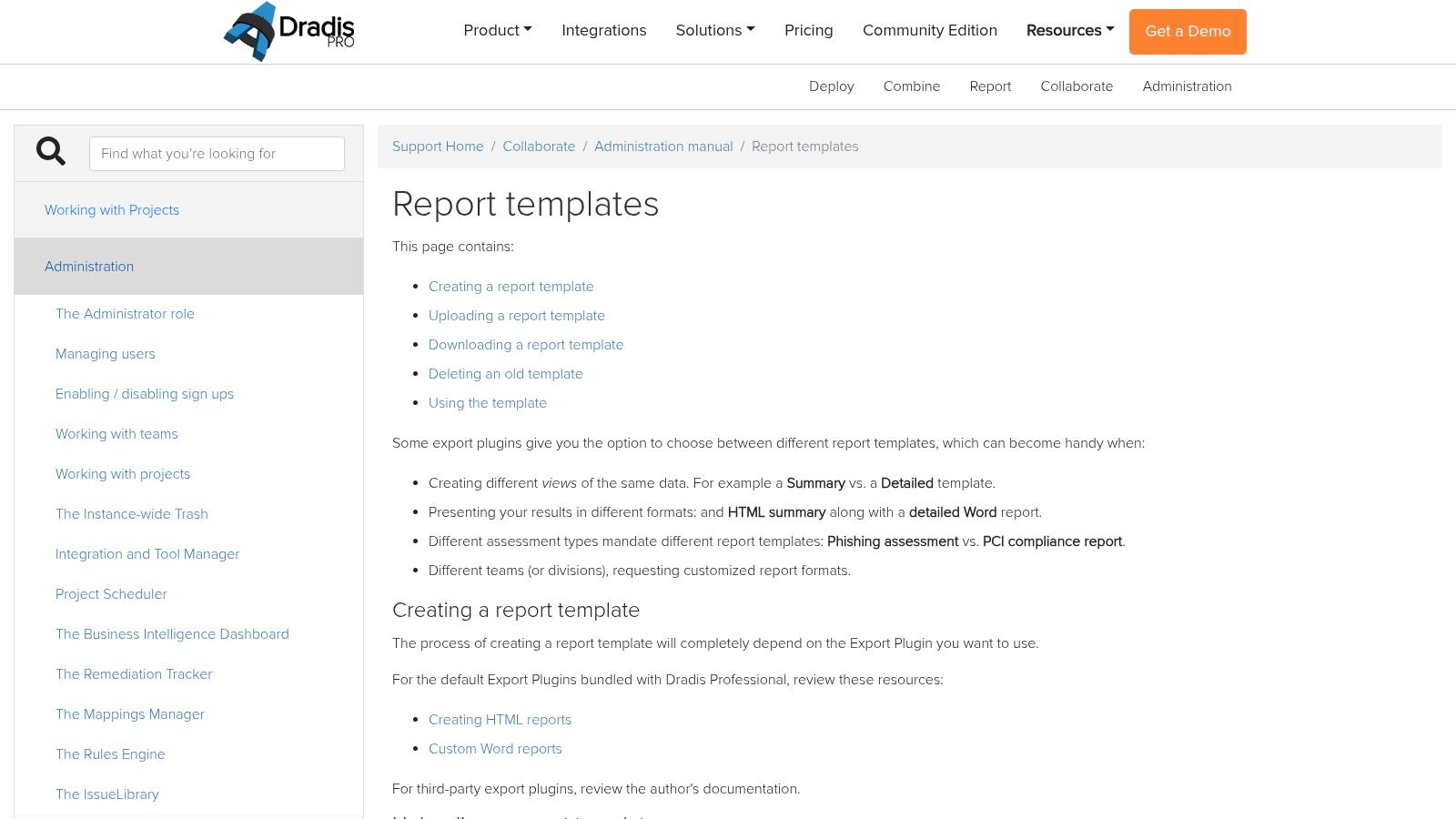
The platform’s strength is its advanced exporters, which support custom templates for Word, HTML, Excel, and PDF. This is perfect for an MSP or vCISO who needs to create consistent, white label pentesting reports for many clients. Dradis offers "Kits," which are bundles of templates and rules designed to standardize your workflow. This is especially helpful for teams doing repeat risk assessments for SOC 2 or ISO 27001 compliance.
While the free community edition is a good start, the paid Pro edition has the most powerful features. Learning the custom fields takes a little time, but it pays off by creating a super-efficient reporting system for your security work.
Key Features & Considerations:
- Best For: Security consultancies and teams needing a robust, centralized platform for standardized reporting.
- Pricing: Free (Community Edition) and paid commercial (Pro Edition) tiers.
- Pros: Deep and well-documented template system, strong community support, and packaged "Kits" for team standardization.
- Cons: The best features are in the paid Pro edition; there is a learning curve to master the template mappings.
Simplify Reports With AttackForge Templates
AttackForge is a complete pentest management and collaboration platform, and its "ReportGen" feature is a big win for teams that need to be efficient. It’s not just a static file; it’s a dynamic system where reports are created on-demand from your findings right in the platform. This is perfect for an MSP or vCISO managing ongoing testing and needing reports fast.

The platform uses customizable DOCX templates that pull data straight from your projects. AttackForge gives you a library of example templates to start with, including pentest and executive summary formats. The real magic is its central findings library, which lets you store and reuse detailed write-ups. This makes all your white-label penetration testing reports consistent and cuts down on repetitive writing.
For GRC pros handling multiple risk assessments for frameworks like PCI DSS or HIPAA, standardizing vulnerability language is a huge help. While it's a paid product, the time saved and report quality can be a great return on investment for busy security teams.
Key Features & Considerations:
- Best For: Security teams and MSPs needing a robust platform to manage the entire pentesting lifecycle, not just reporting.
- Pricing: By quote (Primarily a SaaS platform).
- Pros: Strong out-of-the-box templates, excellent documentation, and a reusable findings library for consistency.
- Cons: Primarily a paid SaaS solution; advanced template customization requires learning some template logic.
Use Tenable Nessus For Quick Reports
Tenable Nessus is a very common vulnerability scanner that has its own reporting features that can serve as a basic template. Instead of starting from scratch, security teams can use the scanner's output to create structured reports right inside the tool. This is great for making baseline vulnerability assessments or for an MSP needing to give clients a quick look at their security.
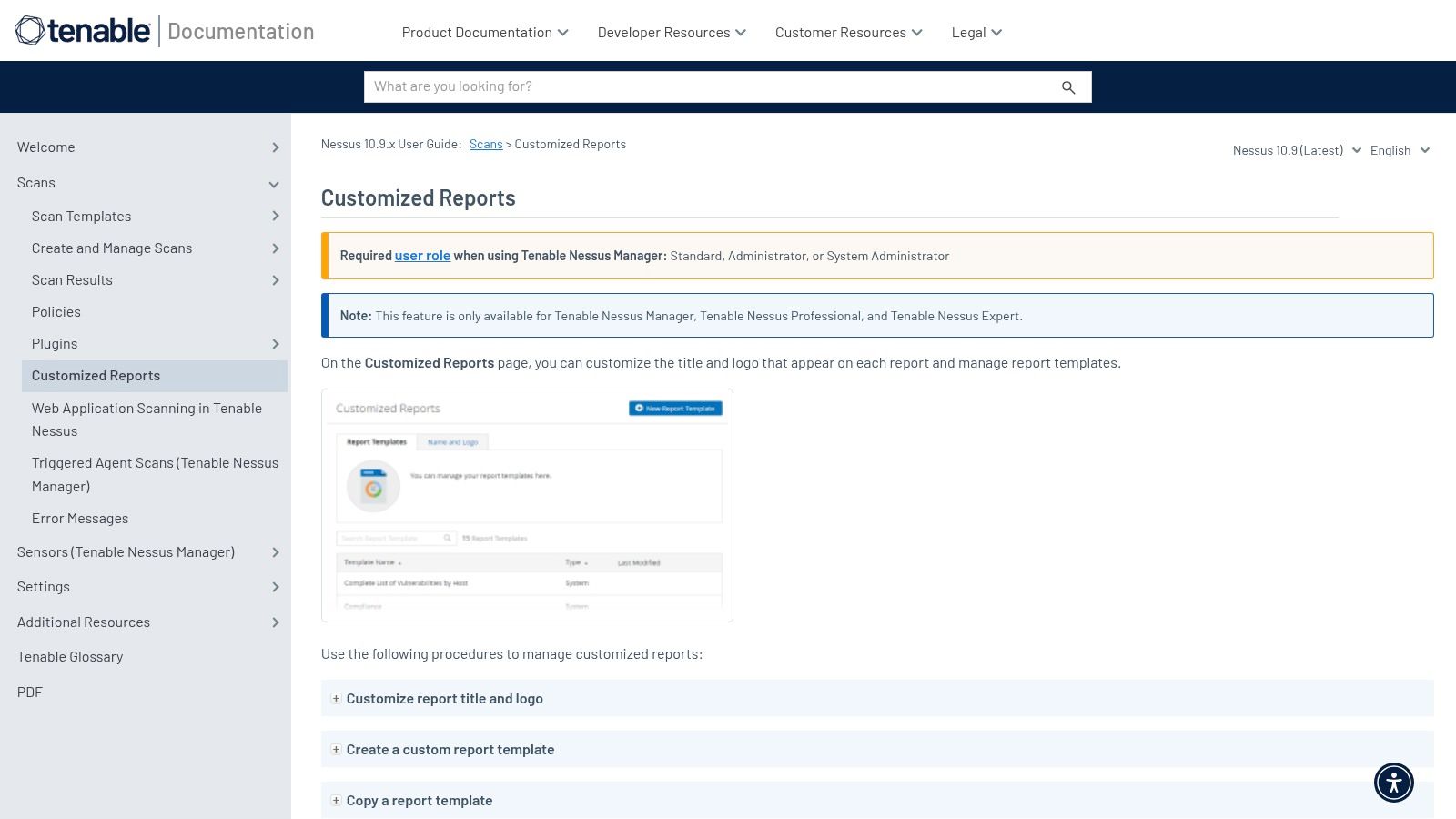
The platform lets you customize report chapters, titles, and logos, making it easy to create branded, white-label penetration testing reports. You can create different report styles for different people, like a simple executive summary for managers and a detailed technical report for IT teams. While these templates are based on scanner data and might not have the story of a manual pentesting report, they are a very efficient place to start. You can learn more about how automated and AI pentesting is changing the game.
For organizations already using Tenable for compliance scans like PCI DSS, using its built-in templates makes the workflow much smoother. You don't have to export data and reformat it, which saves time and prevents mistakes.
Key Features & Considerations:
- Best For: Teams needing quick, scanner-driven vulnerability reports with basic branding.
- Pricing: Included with Tenable Nessus subscriptions (starts at $3,390/year).
- Pros: Familiar tool widely used in the industry; eliminates the need for extra reporting tools for baseline assessments.
- Cons: Oriented to scanner output, may lack narrative for a full pentest; advanced formatting is limited compared to DOCX templates.
Generate Pentesting Reports Using Faraday
Faraday is a collaborative platform for penetration testing and vulnerability management that helps offensive and defensive security teams work together. It’s a full-featured tool with powerful reporting, making it a great choice for teams that want to combine their entire testing process, from collecting data to delivering the final report. It lets teams bring in findings from over 80 different tools into one place.

Its best reporting feature is the ability to create customized DOCX reports quickly. Users can group vulnerabilities, track fixes, and export detailed reports at any time. For an MSP or vCISO who needs to show a structured process for PCI DSS or HIPAA compliance, Faraday also provides methodology templates based on standards like OWASP Top 10. This helps standardize testing and makes sure the final penetration testing report templates meet industry best practices.
While the free community version is limited, the paid versions unlock all the reporting and collaboration tools. This makes Faraday a great option for growing security teams needing a scalable solution that combines real-time teamwork with flexible, professional reports.
Key Features & Considerations:
- Best For: Teams wanting an integrated platform for vulnerability management and reporting.
- Pricing: Community Edition (Free), with paid tiers for advanced features like DOCX export.
- Pros: Centralizes findings from many tools, methodology templates accelerate report structuring, real-time team collaboration.
- Cons: Full reporting functionality is behind a paywall; smaller market presence compared to US competitors.
Try Pentest-Tools.com For Fast Reports
Pentest-Tools.com is a cloud-based platform that combines vulnerability scanning with report creation. It’s built for IT pros and small security teams who need a fast, simple workflow from the first scan to the final report. The platform offers a library of ready-made report templates that you can copy and customize, making it a great choice for getting started quickly.
Its key advantage is the use of templating tags, which automatically pull project data like client names and target info right into the report. This feature cuts down on manual data entry and reduces errors. For resellers like MSPs and vCISOs, the white label branding on Enterprise plans lets them create professional, client-ready penetration testing reports with their own branding.
While the platform is simple, template customization is limited on cheaper plans. To get full white-labeling and deeper editing, you’ll need a more expensive plan. However, for teams focused on speed and combining scanning with reporting for risk assessments, the platform is a great and efficient solution.
Key Features & Considerations:
- Best For: Teams wanting an integrated scanning and reporting platform with simple, reusable templates.
- Pricing: Free basic plan; Paid plans required for advanced reporting features.
- Pros: Quick setup with reusable structures, seamless integration of scanning and reporting.
- Cons: Advanced customization and white-labeling require higher-tier plans; less flexibility on standard tiers.
Visit Pentest-Tools.com →
Get Free And Private Reports With Vulnrepo
Vulnrepo is a free, privacy-first reporting app that works completely in your browser. This means no data ever leaves your computer, making it a secure choice for solo penetration testers or small teams handling sensitive client info. It makes report writing easy by letting you import findings directly from popular scanners like Nmap, Nessus, Burp Suite, and OpenVAS.
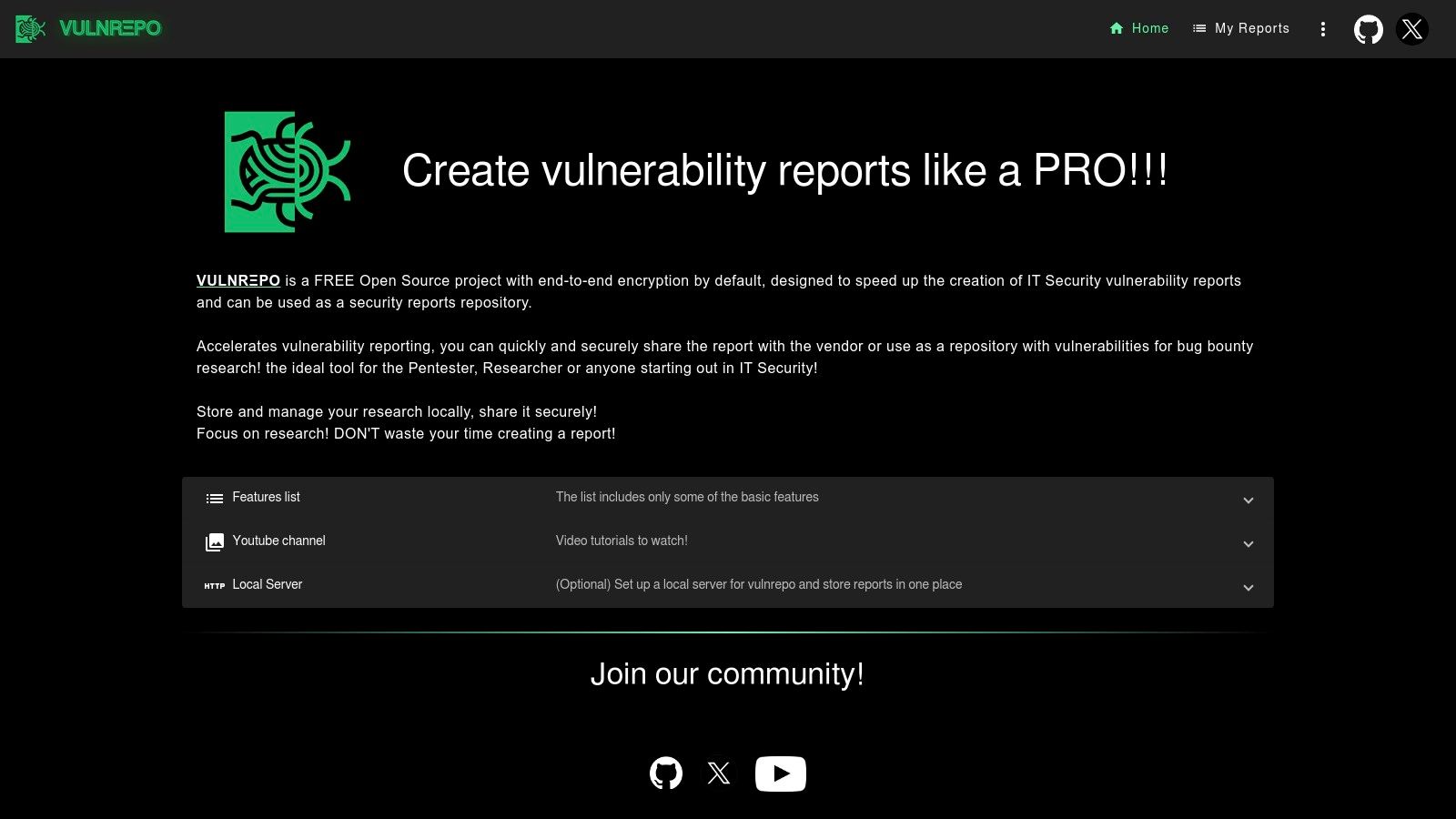
The platform is great because of its customizable issue templates, which let you quickly map findings to frameworks like CWE and MITRE ATT&CK. This is super helpful for making reports for compliance needs like PCI DSS or ISO 27001 without a complicated system. While it's not made for big teams, its ability to quickly create professional penetration testing report templates in DOCX, HTML, or TXT formats makes it a very efficient tool.
For an MSP or vCISO needing a fast, free solution for a single project, Vulnrepo is perfect. The process is simple: import scan data, add details using the templates, and export a clean report. You can even tweak the look with a little CSS, giving you some white label options for free.
Key Features & Considerations:
- Best For: Solo testers and small teams needing a fast, free, and private reporting tool.
- Pricing: Free.
- Pros: Runs locally for maximum privacy, imports from many scanners, and is completely free.
- Cons: Not designed for multi-user collaboration; lighter feature set than enterprise platforms.
Choose PwnDoc-ng For Open-Source Reporting
PwnDoc-ng is a powerful open-source pentest report generator that gives you a great mix of ease-of-use and control. As a newer version of the original PwnDoc, it's actively updated and focuses on team editing, making it great for teams working on complex penetration testing projects. It’s easy to set up with Docker, so you can get a self-hosted reporting system running quickly.

The platform has customizable DOCX templates and a reusable findings database, which makes creating high-quality penetration testing report templates much faster. For MSPs and vCISOs managing many client security audits, this means less time on repetitive writing and more time on analysis. The multi-user support allows for real-time collaboration, ensuring everyone is on the same page when contributing to a single risk assessment.
With support for multiple languages and an active community, PwnDoc-ng is a strong, free alternative to paid reporting tools. It gives you the flexibility to create detailed, professional reports for compliance needs like SOC 2 or ISO 27001 without the high cost.
Key Features & Considerations:
- Best For: Teams wanting a self-hosted, collaborative tool with a strong balance of features and ease of use.
- Pricing: Free (Open-Source).
- Pros: Active community development, great balance of usability and template control, and multi-user support.
- Cons: Requires self-hosting and initial setup; has a smaller ecosystem than major commercial products.
Use Serpico For Proven Report Templates
Serpico is a classic, open-source report generation tool designed to make creating penetration testing reports easier. It lets teams upload and manage custom DOCX templates through its web interface, using a simple language to insert findings and evidence. This is great for teams that want to standardize their report structure and language across all projects.
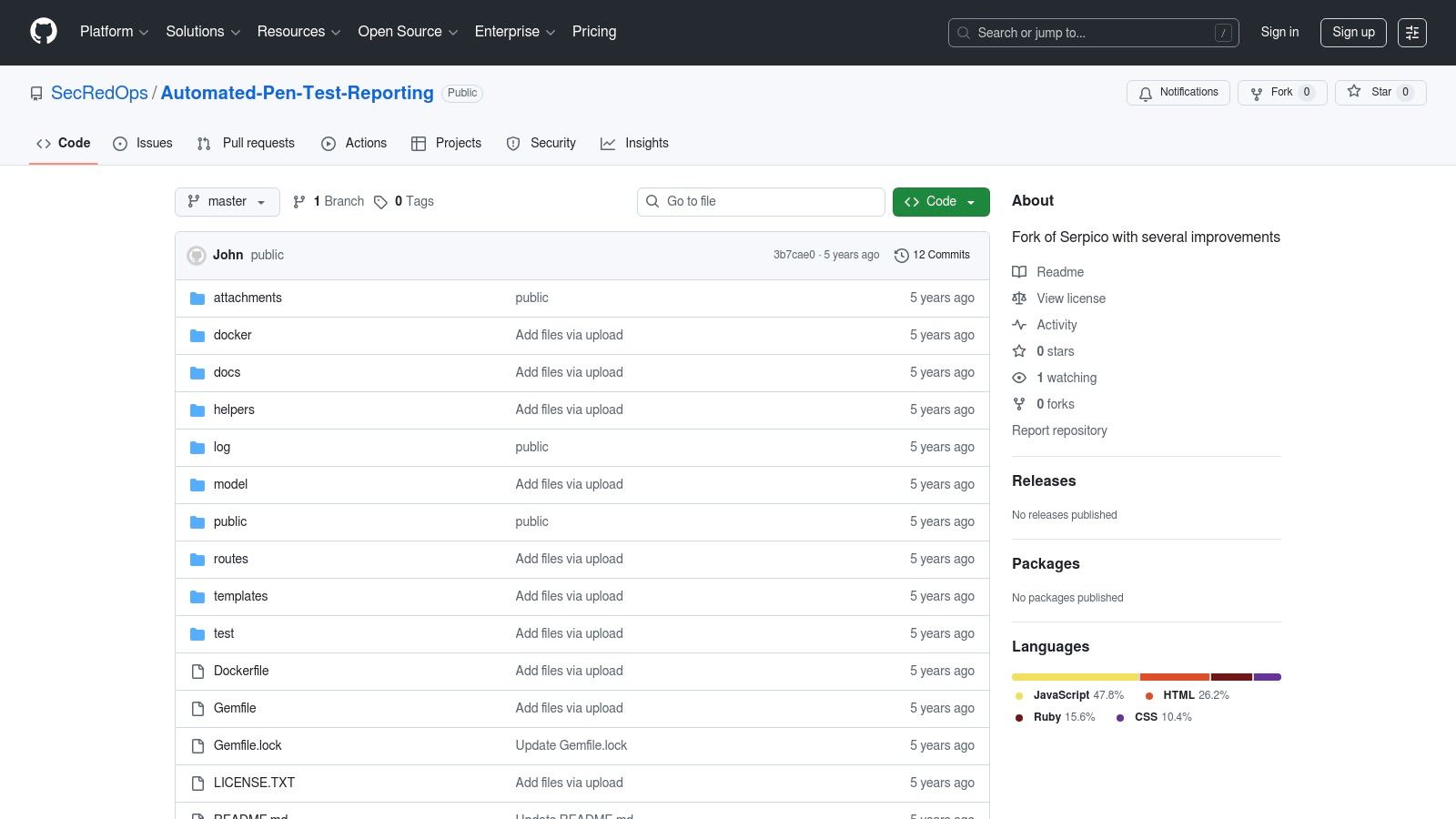
The platform’s strength is its proven DOCX templating system and its findings database. This allows security pros, including any vCISO or MSP, to build a library of pre-written vulnerability descriptions with fix advice. This feature speeds up reporting for common findings in risk assessment projects and ensures high quality. The "fix-and-regenerate" workflow is especially good for making quick updates.
While the original project isn't updated as much, several active forks have kept the platform modern and useful. For teams handling SOC 2 or PCI DSS compliance reporting, Serpico offers a simple, self-hosted solution for creating detailed and repeatable penetration testing report templates.
Key Features & Considerations:
- Best For: Teams wanting a simple, self-hosted tool with a mature DOCX templating model.
- Pricing: Free (Open-Source).
- Pros: Very mature and proven templating, great for standardizing report language and layout.
- Cons: Original project development is slow, so using a maintained fork is recommended; the meta-language has a learning curve.
Visit Serpico (maintained fork) →
Try PenTestReporting.com For Easy Reports
PenTestReporting.com is a paid, web-based platform designed to quickly generate professional penetration testing reports in DOCX format. It simplifies the documentation process for solo testers and small teams by providing pre-filled templates that cover key sections like the Executive Summary, Methodology, and Findings. This approach cuts down the time spent on report creation, making it an affordable alternative for producing client-ready documents.

The platform's best feature is its simplicity. Users can quickly import Nessus CSV files to add findings or enter them manually, then export a fully structured report. While it doesn't have the deep, collaborative features of bigger open-source projects, its strength is how easy it is to get started. For an MSP or vCISO needing a standard report for a risk assessment without a complex system, this tool is perfect. Higher-priced plans add team management and white label branding options.
You can try an example report by signing up for a free account to see if the structure fits your needs. Its straightforward nature makes it one of the most accessible penetration testing report templates available as a service.
Key Features & Considerations:
- Best For: Individual pentesters, small teams, and MSPs needing a fast, simple DOCX report generator.
- Pricing: Starts with a free tier; paid plans are available for more features.
- Pros: Very easy to use, affordable entry-level pricing, and speeds up report generation significantly.
- Cons: Less flexible for complex workflows; primarily focused on the DOCX format.
Get Total Control With GitHub Templates
For consultants and testers who like a hands-on, code-based approach, GitHub has tons of high-quality, open-source penetration testing report templates. These standalone LaTeX and DOCX files offer a lot of control and are perfect for those who manage their work with tools like Git and Markdown, without needing a big reporting platform.
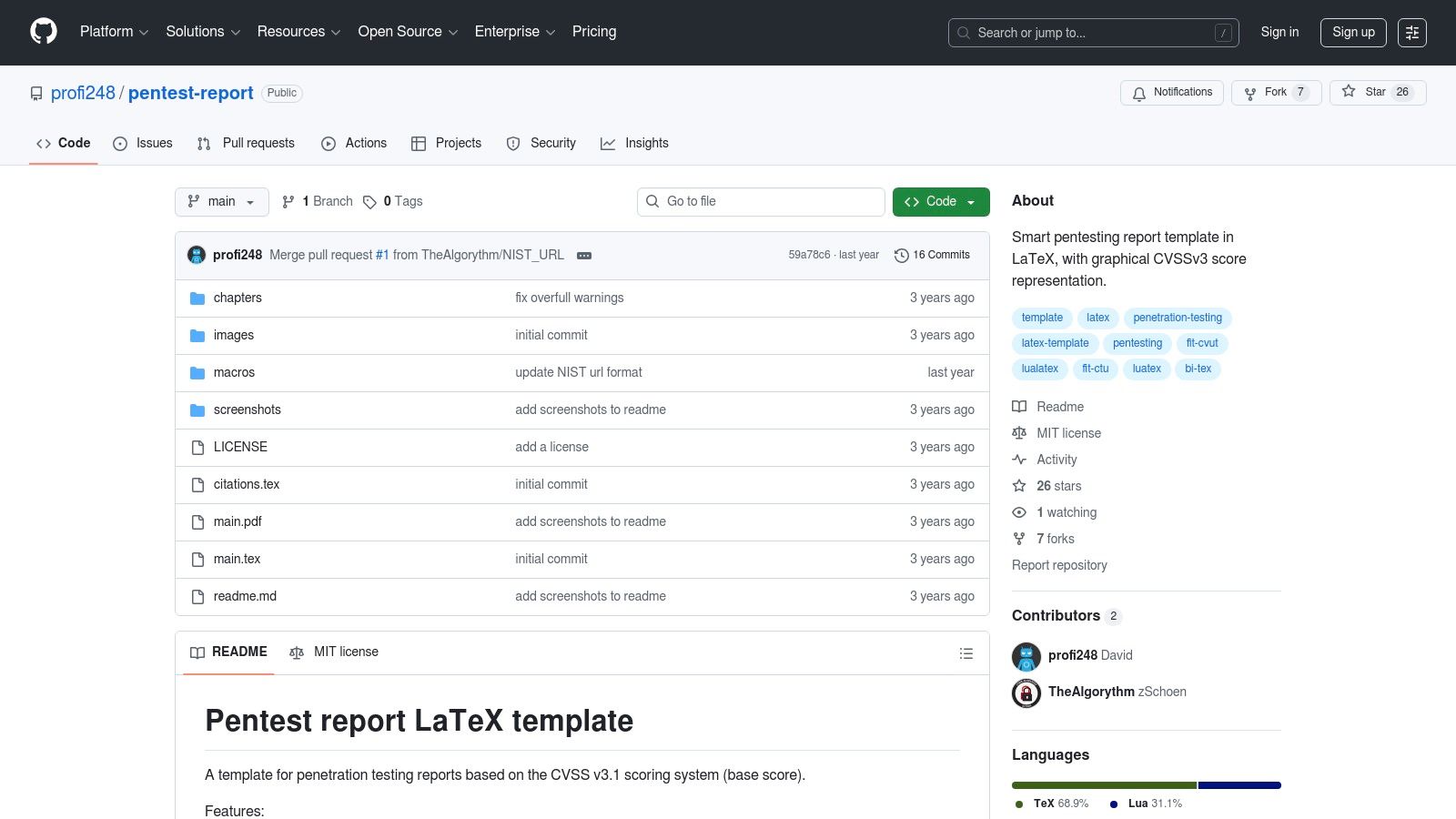
Projects like profi248/pentest-report (LaTeX) provide professionally structured layouts with features like an automatic table of contents and clean severity ratings. The key benefit is complete ownership and customization. You can copy a repository, change it to match your brand, and build it into your own scripts without relying on other services.
This approach is great for delivering a risk assessment or compliance report where a polished, academic look is important. While it requires manual data entry and knowing how to use tools like LaTeX, the result is a crisp, professional document that stands out. Permissive licenses mean you can use and change them for commercial work.
Key Features & Considerations:
- Best For: Independent consultants and small teams comfortable with a Git and code-based authoring workflow.
- Pricing: Free (Open-Source).
- Pros: Total control over the final document, highly professional output, and no platform dependency.
- Cons: Requires technical setup (like a LaTeX toolchain), involves manual data entry, and lacks built-in team collaboration features.
Visit a LaTeX Pentest Template on GitHub →
Choose Us For Fast and Affordable Pentesting
Looking through all these penetration testing report templates shows one thing clearly: the right tool makes you much more efficient. From big platforms like PlexTrac to free tools like Vulnrepo, there are many ways to turn raw vulnerability data into a clear story for your clients.
The key thing to remember is that your choice depends on your team's needs. A big MSP might want a collaborative platform like AttackForge, while a smaller vCISO practice could get great value from a self-hosted tool like Ghostwriter. The goal is always the same: create high-quality, professional reports that explain risk and guide fixes for compliance standards like SOC 2, PCI DSS, and HIPAA.
But even the best penetration testing report templates can't create data out of thin air. A report is only as good as the test itself. This is where many MSPs, vCISOs, and GRC firms get stuck. The pentesting industry often has high prices, long waits for reports, and messy testing methods. These problems make it hard to give your clients timely and affordable security checks.
This is the problem we solve. We are a channel-only partner, which means we work for you, not against you. Our mission is to provide affordable, manual pentesting that helps you serve your clients better. We deliver fast, thorough, and white label pentesting reports from certified pros (OSCP, CEH, CREST). You get a high-quality report that you can brand as your own, making you look like a trusted security expert.
By partnering with us, you can hand off the hard parts of penetration testing and focus on your main business. You bring the strategy; we bring the hands-on expertise. Together, we can improve your security offerings and help your clients stay secure and compliant.
A great report starts with a great pentest. While these penetration testing report templates organize your findings, MSP Pentesting delivers the expert, manual testing needed to uncover critical vulnerabilities. Learn more about our channel-only, white-label pentesting services and see how we can help you deliver exceptional security value to your clients.


.avif)
.png)